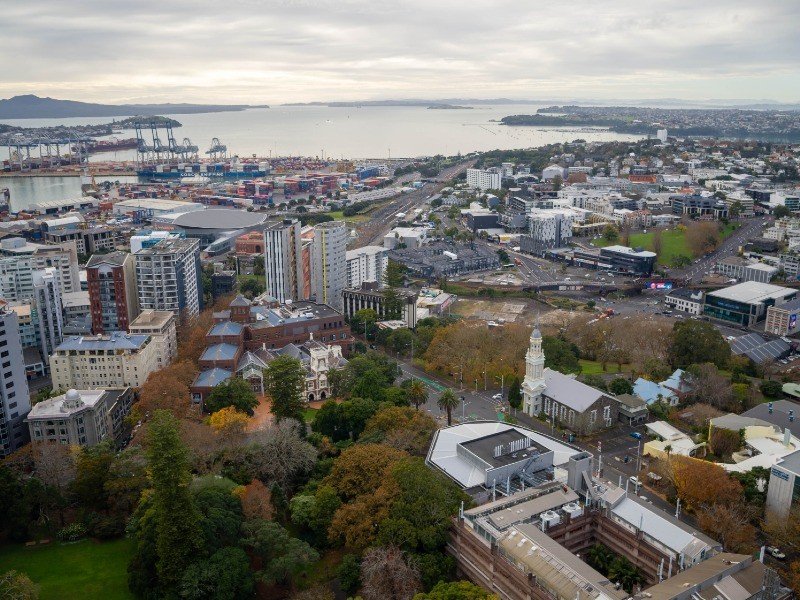
The labour market
Auckland's workforce
Jobs in Auckland by broad skill level
| 2019 | 2023 | Change | |
|---|---|---|---|
| High-skilled | 347,659 | 379,510 | 9.2% |
| Skilled | 121,447 | 131,969 | 8.7% |
| Semi-skilled | 126,492 | 133,505 | 5.5% |
| Low-skilled | 312,366 | 327,315 | 4.8% |
Source: Infometrics: Regional Economic Profile
Auckland’s workforce by ethnicity
| 2019 Q3 | 2024 Q3 | |
|---|---|---|
| European | 533,300 | 517,500 |
| Māori | 87,500 | 100,000 |
| Pacific | 116,200 | 112,300 |
| Asian | 257,800 | 372,200 |
Source: StatsNZ: Household Labour Force Survey
Tāmaki Makaurau Auckland’s workforce is large, diverse and skewed toward high skilled workers.
Auckland has around 1 million workers, more than a third of the national total. Reflecting Auckland’s population, it is an ethnically diverse and relatively young workforce.
To staff its high value service industries, it has a large amount of high skilled workers – a greater proportion than the rest of New Zealand. The number of highly skilled workers is growing faster than the total workforce. A skilled workforce can provide Auckland with a competitive advantage over other regions for business investment.
-
Around 1,000,000 people are employed in Auckland in 2024 (Q1), 34% of the New Zealand total.
The number of people employed has increased by 10% over the last five years, outpacing population growth.
A further 50,000 people are unemployed in 2024 (Q1).
-
Auckland’s labour force is now more diverse than 2019, with a reduction in the number (and proportion) of European workers. This trend is likely to continue, driven by migration from Asia, and more Māori and Pacific youth entering the workforce.
StatsNZ population projections suggest that Asian Aucklanders could account for 46% of the working age population by 2043, with the proportion of workers who are Māori or Pacific also increasing.
-
In 2023, low skilled jobs made up 34% of Auckland’s employment while high skilled jobs made up 39%.3
This is slightly more skewed toward high skilled jobs than the rest of New Zealand.
A further 14% of jobs are ‘skilled’, thus over half of Auckland’s jobs are skilled or high skilled.
The proportion of high skilled jobs has increased slightly since 2019 (38% to 39%), and is up from 35% in 2008.
36% of jobs in Auckland are ‘knowledge-intensive’, higher than the rest of New Zealand (31%).
Areas of Auckland’s economy with the highest number of ‘knowledge-intensive’ jobs include hospitals, IT, management consulting, education and engineering.
3.High skilled occupations typically require a Bachelors degree or higher qualification. They include professionals such as accountants, teachers and engineers, as well as most managers and executives. This category is consistent with skill level one of the Australia New Zealand Standard Classification of Occupations (ANZSCO). Low skilled occupations typically require an NZ Register Level 3 qualification or lower. They include a range of lower skilled occupations from general clerks, caregivers, sales assistants, cleaners and labourers. This category is consistent with skill level four and five of the ANZSCO classification.
Sources: Employment size, population growth, region’s skill level – Infometrics: Regional Economic Profile. Workforce ethnicities, workforce ethnicity by age – StatsNZ: Household Labour Force Survey
Employment trends
| 2019 | 2023 | |
|---|---|---|
| Professional, scientific and technical services | 110,700 | 122,900 |
| Construction | 87,000 | 102,500 |
| Health care and social assistance | 78,800 | 88,500 |
| Retail trade | 77,800 | 85,300 |
| Manufacturing | 83,200 | 84,900 |
| Education and training | 67,700 | 67,500 |
| Wholesale trade | 64,000 | 65,900 |
| Accommodation and food services | 58,600 | 60,100 |
| Administrative and support services | 56,900 | 56,000 |
| Transport, postal and warehousing | 43,800 | 44,900 |
| Financial and insurance services | 36,300 | 41,000 |
| Public administration and safety | 33,600 | 38,600 |
| Other services | 33,500 | 35,600 |
| Rental, hiring and real estate services | 24,500 | 26,200 |
| Information media and telecommunications | 22,800 | 22,700 |
| Arts and recreation services | 15,300 | 15,700 |
| Agriculture, forestry and fishing | 8,100 | 7,500 |
| Electricity, gas, water and waste services | 5,000 | 6,000 |
| Mining | 400 | 400 |
Employment by industry in Auckland
Source: Infometrics: Regional Economic Profile
Unemployment and labour force participation rates in Auckland
(year end annual averages)
Source: StatsNZ: Household Labour Force Survey.
Auckland has a predominantly service-based economy, although employment isn’t always concentrated in the areas with the highest GDP contribution.
Only two of Auckland’s five largest employing industries are also in the five largest GDP contributors (‘professional, scientific and technical services’ and ‘manufacturing’). There is significant employment, but relatively less GDP contribution, in labour-intensive industries such as construction, accommodation and food services, and retail trade. There is relatively less employment in industries such as ‘financial and insurance services’ and ‘information media and telecommunications’, although these contribute a lot of GDP. This reflects the differences in labour productivity (GDP per worker) across industries.
Auckland’s five largest employing industries remain the same as before COVID. While there were significant impacts on businesses and employment during that time, overall employment levels remain similar.
-
Auckland’s employment structure favours the service industries, which account for 79% of employment.
Auckland’s primary industries employ a significantly smaller (0.8%) proportion than the rest of New Zealand (8.1%).
The professional, scientific and technical services industry is the largest employer in Auckland (13% of jobs), followed by construction (10.5%).
While the largest industries by employment count remain the same as pre-COVID, certain industries fared better than others.
The two largest industries in Auckland also saw the biggest increase in jobs, while health care and social assistance is now the third largest employer.
Retail employment grew by nearly 7,500 despite the impact of lockdowns.
Employment growth in ‘wholesale trade’, ‘accommodation and food services’, ‘manufacturing’ and ‘transport, postal and warehousing’ was particularly subdued compared to the 2015-2019 period.
Employment growth was negative in information media and telecommunications, education and training, primary industries, and administrative and support services.
Auckland currently has a low unemployment rate, and high labour force participation rate, relative to historical levels.
Tāmaki Makaurau Auckland has a labour force participation rate of 74%, which means nearly three-quarters of working age (15-64) Aucklanders have or are seeking a job. This is higher than in 2019, and higher than the rest of New Zealand.
Auckland’s unemployment rate is relatively low, compared with historical levels. However, unemployment has increased between March 2023 and March 2024.
Low unemployment and high labour force participation suggests there are broadly sufficient employment opportunities for Aucklanders. However increasing unemployment suggests this situation is fragile.
-
Auckland’s participation rate was 74% in Q1 of 2024.
This is higher than in 2019 (71%), and higher than the New Zealand-wide value (72%).
Male participation is higher than females (79% vs 70%), but the gap has closed slightly since 2019.
Labour force participation fell slightly in the initial months of COVID-19 (2020), but has increased since.
Participation rates have increased for all ethnicities since 2019.
The largest increases have been seen in the Asian (+5.9 percentage points) and Pacific (+3.5 percentage points) ethnic groups.
The Asian participation rate (78%) is now above the European rate (75%) for the first time in the data series (2009 – present).
-
Auckland’s unemployment rate was 4.1% in Q1 2024.
This is slightly above the national rate (4.0%).
This is similar to the 2019 level (4.2%), but up from 12 months ago (3.4%).
Infometrics is forecasting a potential rise in unemployment to 5% by the end of 2024.
-
There were 20,000 more Aucklanders receiving Jobseeker support in Q4 2023 than in Q4 2019. Auckland’s proportion of national Jobseeker support recipients has increased from 31% in 2019 to 34% in 2023.
Auckland’s youth NEET rate at the end of 2023 was 11.6%, down from the pandemic peak of 14% and similar to the rate in the years preceding the pandemic.
Sources: Employment sectors, share of employment and GDP – Infometrics: Regional Economic Profile. Participation rate by region and age group – StatsNZ: Household Labour Force Survey
Earnings
Mean annual earnings and growth in Auckland (March Year, nominal values)
Average earnings in Auckland are higher than the rest of New Zealand, and have kept pace with inflation over the last few years.
The average Auckland employee currently earns around $81,000 annually. This is higher than the rest of New Zealand, although lower than for Wellington employees. Earnings have continued to grow over time, including through the COVID-19 period.
-
The average Auckland employee earns $81,400 annually (year to March 2023), an increase of 7.6% compared to the previous year.
This is 15% greater than an average employee across the rest of New Zealand.
Average earnings in Wellington are slightly higher ($82,700) than in Auckland.
Average earnings for Māori ($74,300) and Pacific peoples ($65,300) are lower than the Auckland average.
Auckland has strong clusters of highly paid jobs in certain industries.
The average wage among Auckland’s leading ICT companies was $106,000 according to 2022 data from the Technology Investment Network (TIN).
-
From 2010-2020, Auckland employees’ earnings have grown by between 1.8% and 3.6% each year. On average this is slightly higher than inflation (CPI) over the same period.
2023 average earnings are 20.6% higher than in the year to March 2019, with inflation (CPI) increasing 18.7% over the same period.
This was driven by a significant increase in earnings in the years to March 2022 (6.2%) and 2023 (7.6%). The 2023 increase was the highest this century.
Earnings growth across the rest of New Zealand followed a similar trend.
These high growth rates have been influenced by historically high inflation rates and the associated impact on the cost of living.
Sources: Unemployment rate, earnings, earnings growth, mean annual earnings – Infometrics: Regional Economic Profile. Auckland unemployment and participation rate – StatsNZ: Household Labour Force Survey
Auckland Economic Monitor
A summary of key economic information about the region
Auckland’s economy: What’s changed?
Deep dives
Cost of living
Inflation reached levels not seen since the 80s in 2022 and remains above historical levels.
Investment & trade
Auckland plays a significant role in the country’s investment and trade landscape.
Auckland’s industrial employment areas
Trends over the last two decades.










